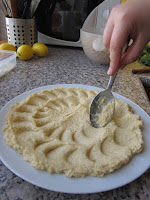When Jeff announced his great visa success, our lovely Lebanese friend presented him with the perfect "welcome home" gift: a Lebanese cookbook - and a promise to spend a day cooking with us.
 |
| Plating hummus |
We thus had our very own Lebanese cooking class a couple weekends ago, in which said friend taught us how to make hummus, tabbouleh, kefta, and fattoush just like her mother makes hummus, tabbouleh, kefta and fattoush. We also made falafel from scratch, but that was a new adventure for all of us.
All of these dishes are surprisingly straight forward (though they can be time consuming - try soaking and peeling a pound of fava beans, and you'll know what I mean). There's also a surprising amount of room for variation. Take tabbouleh, for instance: our friend feels very strongly about the fineness of the burghul (bulgar) -- it should be #1 burghul, not #2 -- and the amount (according to her, hardly any).
Other interesting notes on making tabbouleh: traditionally, you layer the ingredients carefully - the top layer being half onions and half tomatoes, neatly divided - and wait to mix in the dressing (lemon juice and olive oil) until you are ready to eat. Also, the spices are best mixed with the onions before the onions are added to the salad, as this helps ensure their even distribution in the final product.
Here's a general recipe for tabbouleh, copied/adapted from Lebanese Cuisine by Madelain Farab (who just happens to be a Portlander):
 |
| A little heavy on the tomatoes, imho |
1/4 to 3/4 cup burghul (Farab recommends #2)
2 large bunches parsley, chopped very fine
About 1/4 as much fresh mint, also chopped fine
A few green onions, finely chopped (including the green part)
1 small onion, finely chopped and mixed with a bit of sumac, salt and pepper
2 large tomatoes, finely chopped
About 1/2 cup lemon juice and 1/2 cup olive oil (dress the salad to taste)
Rinse the burghul, drain it and squeeze it dry. Place it in a large mixing bowl and layer the parsley, mint, and green onions on top. Put the seasoned onions on one half of the salad and the tomatoes on the other half. When ready to serve, toss the salad with some lemon juice and olive oil (it should be fairly wet). Traditionally, the salad is eaten using grape leaves or lettuce (think pita bread and hummus).
As you can see, most of the work is in the chopping. Personally, I like more grain in the tabbouleh and more olive oil than lemon juice, but I can admit that here because I don't think our friend reads this blog.
Albeit tasty, I don't think sumac is very common. "There's no substitute for sumac!" But you could use paprika to get the same appearance.
ReplyDelete